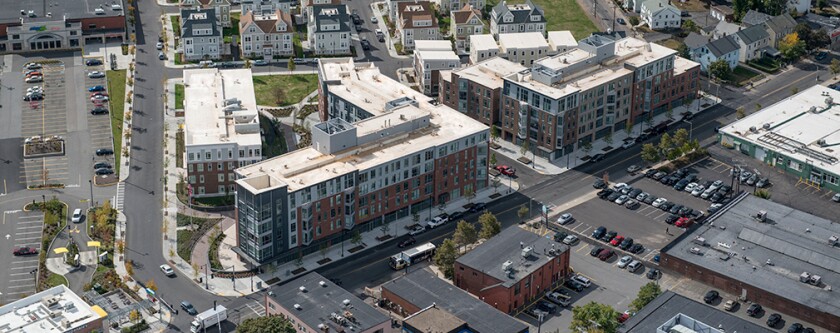
(Photo: HUD)
In the past, affordability was defined as households being able to spend less than 30 percent of their budget on housing, but many experts now define it as spending less than 45 percent on housing and transportation combined. That definition recognizes that a cheap house is not truly affordable if it’s located in an isolated area with high transportation costs, and that households can rationally spend more for housing in a walkable, mixed-use neighborhood where transportation is cheaper.
This has important policy implications beyond simply increasing the supply of homes that people can afford. Smart-growth policies that increase affordable infill — more housing in existing residential areas — also can help achieve many economic, social and environmental goals. We know that children tend to be happier, healthier and more successful if they grow up in high-opportunity neighborhoods: areas with mixed incomes, good schools and convenient access to services and jobs.
There is passionate debate concerning how to increase affordability and opportunity. At one extreme, free-market advocates point to lower housing prices in sprawling cities such as Houston and Atlanta as evidence that deregulation increases affordability. However, they ignore the high transportation costs in those areas, which offset their lower housing costs, and the infeasibility of such solutions in geographically constrained cities such as New York and Seattle, which must grow up, not out.

Most planning experts take a more nuanced approach. While upzoning certainly has its skeptics, it’s clear from the strongest research that true affordability requires a combination of upzoning policies to encourage more moderate-priced “missing middle” housing in high-opportunity neighborhoods, plus subsidized housing for households with special needs.

Upzoning can significantly reduce housing-development costs. Townhouses typically cost 30 percent less per unit, and apartments 50 percent less, than comparable-quality single-family homes. Increasing the supply of such housing tends to increase both moderate- and lower-priced housing affordability through “filtering.” That occurs as some residents of lower-priced homes move into the new units and over time the new homes depreciate, adding to the supply of naturally occurring affordable housing, which represents the majority of low-priced housing in most communities.
Upzoning supports both market and subsidized housing. A million-dollar subsidy budget, for example, could typically produce only two single-family houses with two-car garages, five townhouses with one off-street parking space or 10 apartments with unbundled parking (parking spaces rented separately).
Extensive research, using various data sets and analysis methods, supports the conclusion that upzoning can increase affordability. A major study by economist Evan Mast, for example, tracked the previous residences of the occupants of 802 new multifamily developments in 12 North American cities. It found that building market-price apartments causes a kind of housing musical chairs as households move into new units. For every 100 new market-rate units built, approximately 65 units are freed up in existing buildings, accommodating up to 48 moderate- and low-income families. Another study, by New York University’s Xiaodi Li, found that in New York City each 10 percent increase in multifamily housing supply reduces nearby rents and sales prices by 1 percent.
And a study for the National Multifamily Housing Council on the effects of filtering found that affordability increased during periods of higher multifamily construction and declined when new development was lower. As authors Dowell Myers and JungHo Park explained, “In decades past it was the substantial flow of new construction, largely targeted to middle- and higher-income groups, that enabled the filtering process to operate. In the face of its current constriction, well below levels normally associated with employment growth, we gain fresh appreciation for the broader benefits of housing construction.”
The conclusion is inescapable: If we want more affordability, build more moderate-price houses. Here are the highlights of my recipe for true affordability, opportunity and community livability:
● Upzone urban neighborhoods to allow missing middle housing. This responds to growing demand for such homes.
● Reduce fees, approval requirements and inclusivity mandates for moderate-priced infill housing in walkable urban neighborhoods, since these are the projects we most need.
● Reduce or eliminate parking minimums and favor unbundling so residents are not forced to pay for expensive parking facilities they do not need.
● Create mixed-use 15-minute neighborhoods where commonly used services are located within a convenient walk or bike ride from most homes and worksites, and improve affordable transportation modes, including walking, bicycling and public transit.
● Improve affordable housing design. The Affordable Housing Design Advisor, the Missing Middle Housing website and Portland, Oregon’s Infill Design project provide design resources.
● Subsidize housing for people with special needs, including those with disabilities and low incomes.
Todd Litman is the founder and executive director of the Victoria Transport Policy Institute, headquartered in Victoria, British Columbia.
Governing's opinion columns reflect the views of their authors and not necessarily those of Governing's editors or management.







